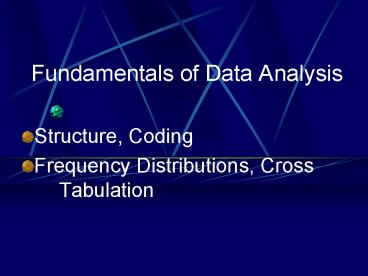Fundamentals of Data Analysis - PowerPoint PPT Presentation
1 / 18
Title:
Fundamentals of Data Analysis
Description:
Statistical analysis technique to study the relationships among and between variables ... Both median and mode can be used for ordinal scale ... – PowerPoint PPT presentation
Number of Views:148
Avg rating:3.0/5.0
Title: Fundamentals of Data Analysis
1
- Fundamentals of Data Analysis
- Structure, Coding
- Frequency Distributions, Cross Tabulation
2
Data Analysis
- A set of methods and techniques used to obtain
information and insights from data - Helps avoid erroneous judgements and conclusions
- Can constructively influence the research
objectives and the research design
3
Preparing the Data for Analysis
- Data Editing
- Identifies omissions, ambiguities, and errors in
responses - Conducted in the field by interviewer and field
supervisor and by the analyst prior to data
analysis
4
Preparing the Data for Analysis
- Problems Identified With Data Editing
- Interviewer Error
- Omissions
- Ambiguity
- Inconsistencies
- Lack of Cooperation
- Ineligible Respondent
5
Preparing the Data for Analysis
- Statistically Adjusting the Data Variable
Re-specification - Existing data is modified to create new variables
- Large number of variables collapsed into fewer
variables - Creates variables that are consistent with study
objectives - Dummy variables are used (binary, dichotomous,
instrumental, quantitative variables)
6
Preparing the Data for Analysis
- Scale transformation
- Scale values are manipulated to ensure
comparability with other scales - Standardization allows the researcher to compare
variables that have been measured using different
types of scales - Variables are forced to have a mean of zero and a
standard deviation of one - Can be done only on interval or ratio scaled data
7
Simple Tabulation
- Consists of counting the number of cases that
fall into various categories - Determine empirical distribution (frequency
distribution) of the variable in question - Calculate summary statistics, particularly the
mean or percentages - Aid in "data cleaning" aspects
8
Frequency Distribution
- Reports the number of responses that each
question received - Organizes data into classes or groups of values
- Shows number of observations that fall into each
class - Can be illustrated simply as a number or as a
percentage or histogram - Response categories may be combined for many
questions - Should result in categories with worthwhile
number of respondents
9
Descriptive Statistics
- Statistics normally associated with a frequency
distribution to help summarize information in the
frequency table - Measures of central tendency mean, median and
mode - Measures of dispersion (range, standard
deviation, and coefficient of variation) - Measures of shape (skewness and kurtosis)
10
Analysis for Various Population Subgroups
- Differences between means or percentages of two
subgroup responses can provide insights - Difference between means is concerned with the
association between two questions - Question upon which means are based are
intervally scaled
11
Cross Tabulations
- Statistical analysis technique to study the
relationships among and between variables - Sample is divided to learn how the dependent
variable varies from subgroup to subgroup - Frequency distribution for each subgroup is
compared to the frequency distribution for the
total sample - The two variables that are analyzed must be
nominally scaled
12
Factors Influencing the Choice of Statistical
Technique
- Type of Data
- nominal, ordinal, interval and ratio scales of
measurement - Nominal scaling is restricted to the mode as the
only measure of central tendency - Both median and mode can be used for ordinal
scale - Non-parametric tests can only be run on ordinal
data - Mean, median and mode can all be used to measure
central tendency for interval and ratio scaled
data
13
Overview of Statistical Techniques Univariate
techniques
- Appropriate when there is a single measurement of
each of the 'n' sample objects or there are
several measurements of each of the n'
observations but each variable is analyzed in
isolation - Non-metric - measured on nominal or ordinal scale
- Metric-measured on interval or ratio scale
- Determine whether single or multiple samples are
involved - For multiple samples, choice of statistical test
depends on whether the samples are independent or
dependent
14
Overview of Statistical TechniquesBi-variate
techniques
- Two interval variables
- Correlation, regression, t-test
- Two nominal variables
- Contingency coefficient, Chi-square test
- Two ordinal variables
- Rank correlation, MW U-test, KS test
15
Overview of Statistical TechniquesMultivariate
techniques
- Dependence Techniques
- One or more variables can be identified as
dependent others are independent - Interdependence Techniques
- Examines a set of interdependent relationships
16
Why use Multivariate Analysis?
- To group variables or people or objects
- To improve the ability to predict variables (such
as usage) - To understand relationships between variables
(such as advertising and sales)
17
Summary
- Understand the purpose of data analysis
- Preparing date involves editing correcting
numerous problems - variable re-specification, scale transformation
- Analysis process moves from simple tabultions to
descriptive statistics, to cross-tabulations and
analysis of sub-groups - Choice of analysis technique is made from
univariate, bi-variate, or multi-variate
techniques
18
Notes on the SPSS assignment 2






![[PDF] Fundamentals of Urine and Body Fluid Analysis 5th Edition Android PowerPoint PPT Presentation](https://s3.amazonaws.com/images.powershow.com/10078427.th0.jpg?_=20240713106)
























